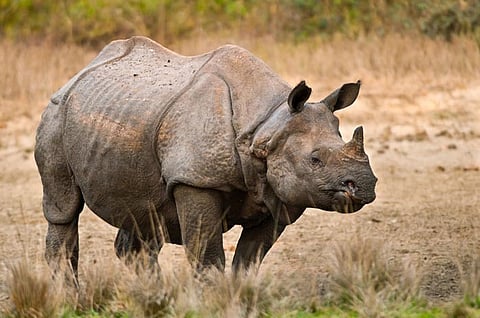
- Home
- Live Blog
- Breaking News
- Top Headlines
- Cities
- NE News
- Sentinel Media
- Sports
- Education
- Jobs

A CORRESPONDENT
BOKAKHAT: Kaziranga National Park and Tiger Reserve is currently facing a severe water crisis. Due to an extended dry spell and lack of rainfall this year compared to previous years, water bodies like wetlands, rivers, and streams inside the park have dried up. As a result, aquatic life along with animals like rhinos, elephants, and buffaloes are facing serious problems.
It’s noteworthy that the primary water source for Kaziranga National Park is the Brahmaputra River, which flows along the northern boundary of the park. In addition, several streams like Jan, Juri, and Nijora flowing from the southern Karbi Hills also contribute to the park’s water supply. However, due to a significant decrease in rainfall in both the plains and the Karbi Hills, these water sources have nearly stopped replenishing the park.
According to a departmental source, the park comprises about 100 permanent water bodies and nearly 200 seasonal wetlands. The Brahmaputra and the streams from the Karbi Hills, along with these water bodies, serve as the main sources of drinking water for wildlife inside the park. But due to the prolonged drought, the water level in these wetlands has been gradually decreasing. Some have even dried up completely, raising concerns of a water crisis for the animals.
Meanwhile, tour guide Bitopan Kalong shared with the media that the drying up of certain water bodies inside the park is visibly causing distress among the wildlife. The lack of rainfall is believed to be a major reason behind this crisis. Consequently, some animals are being forced to leave the park’s interior in search of water in nearby human settlements, increasing the risk of human-wildlife conflict.
It is extremely difficult for wildlife in the park, especially rhinos, elephants, and buffaloes, to survive without adequate water. These animals often cool off by bathing in water, which also helps protect them from harmful microbes and various skin diseases. Without access to water or muddy areas to wallow in, the risk of infections and diseases increases significantly, as per wildlife experts.
With rising temperatures and water scarcity, reports suggest that rhinos, elephants, and buffaloes are becoming more agitated. There have even been incidents where distressed animals have charged at tourist vehicles inside the park. Environmentalists suggest that scientific methods of water conservation, such as constructing controlled embankments around water channels and wetlands within the park, could help mitigate such crises in the future.
Also Read: Meitei, Kuki-Zo-Hmar Groups to Hold Tripartite Talks with MHA in Delhi
Also Watch: